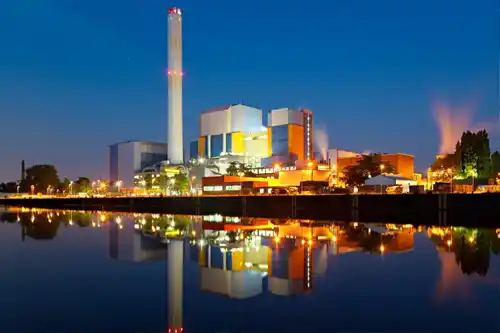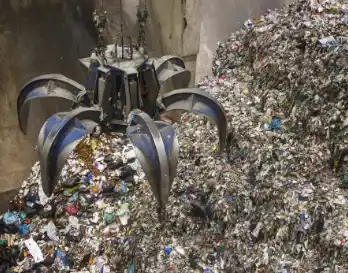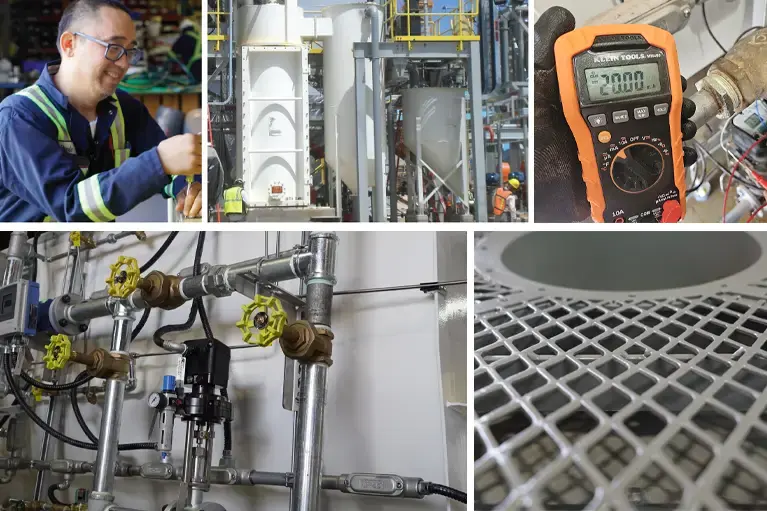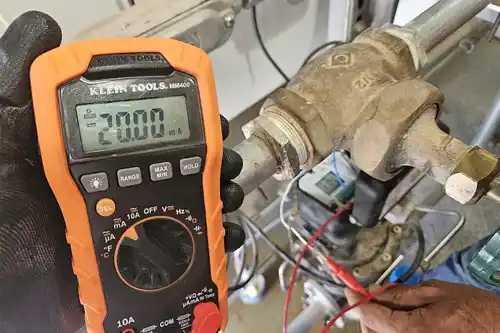Flue Gas Treatment
Carmeuse Systems offers a range of storage and handling equipment for lime and other dry bulk reagents, lime slakers, and pneumatic conveying systems to help address the needs of flue gas treatment and other Waste-to-Energy facilities.

How is Lime Used in Flue Gas Treatment?
Lime is a key component in flue gas treatment applications, as it is primarily used to remove sulfur dioxide (SO2), hydrochloric acid (HCl), heavy metals, and other particulate pollutants from emissions. Flue gas desulfurization (FGD) applications involve injecting liquid lime slurry into the flue gas stream, while other approaches, such as dry sorbent injection (DSI), inject a dry, powdered sorbent, such as hydrated lime, directly into the flue gas. Overall, lime’s effectiveness in neutralizing acidic gases helps reduce air pollution, making it an essential part of modern industrial emission control systems.

What is Waste-to-Energy?
Waste-to-energy involves the use of municipal solid waste (MSW) – the garbage you discard everyday into trash cans – to produce electricity. The traditional waste-to-energy process uses steam to turn a turbine to generate electricity. The steam is generated by burning the MSW. It is thus similar to conventional thermal power generation, but replaces traditional fuels (gas, coal) with waste.
The most common waste-to-energy facilities in the US are static mass burn facilities. These burn the MSW in a single combustion chamber on a sloping, moving grate. The MSW travels through the combustion chamber on a moving grate that agitates the trash, mixing it with the heated combustion air inside the chamber to ensure complete burn-out of the trash.
The Benefits of Waste-to-Energy
Burning MSW has a number of benefits. It recovers energy contained within the waste. According to the US Energy Information Administration (EIA) statistics, waste-to-energy plants generated about 13.5 billion kWh of electricity in 2020 via the combustion of 25 million tons of MSW.
The waste-to-energy process also has advantages when it comes to waste management because it reduces the amount and volume of material sent to landfill. Again according to the EIA, waste-to-energy plants will turn 2,000lb of garbage into between 300lb and 600lb of ash, and reduce the volume of that waste by about 87%.
This ash comes in two forms. Fly ash – also known as air pollution control residue – is entrained in (and subsequently removed from) the flue gas, while bottom ash (as the name suggests) collects in the bottom of the combustion chamber.
While many utility grade ashes can often be beneficially utilized, waste-to-energy ash reuse needs to be evaluated case by case due to inconsistencies in ash inherent to waste incineration. Possible beneficial reuse could include a secondary aggregate for bulk filling in construction. There is also ongoing research into the use of waste incineration ashes in concrete and mortars, or as an alternative raw material in cement clinker production.
HowisLimeUsed
How is Lime Used at Waste-to-Energy Plants?
Waste-to-energy plants are under pressure to comply with regulation and consent decrees that include lower emissions limits for acid gases and heavy metals. Lime is used to help manage both via its use:
- In air pollution control (APC or scrubber) systems
- To stabilize heavy metal in waste incineration ash
Lime in Air Pollution Control Systems

Lime is an important part of many pollution control systems. According to the National Lime Association, more than 90% of flue gas desulfurization systems in the US use lime or limestone. Because lime also freely reacts with other elements, lime scrubbing can be used to control other acidic gases such as hydrogen chloride (HCl) and hydrogen fluoride (HF).
There are a number of air pollution control technologies available, all of which involve the use of lime.
- Dry scrubbers involve the injection of dry hydrated lime (Ca(OH)2) directly into the flue gas duct. The lime reacts with the pollutants, and the product of these reactions can then be removed from the flue gas via a baghouse.
- Circulating dry scrubbers also inject dry hydrated lime (or humidified, pulverized quicklime) but do so into a separate reaction vessel.
- Semi-dry (or spray) scrubbers are similar to dry scrubbers but the lime is injected as an atomized lime slurry. The water in the lime slurry is evaporated by the hot flue gas, and the dried hydrated lime then reacts with the pollutants as in dry scrubbers.
- In wet scrubbers, the flue gas passes through a shower of lime slurry. The pollutants are absorbed into the spray, and then precipitated out for disposal or utilization (e.g., SO2 is precipitated as wet calcium sulfite, which can be converted to gypsum).
Semi-Dry scrubbers are the more common choice in waste-to-energy processes due to their smaller space requirements, operating costs and simple waste disposal (dry rather than a wet sludge as is produced by wet scrubbers).
Semi-Dry scrubbers are also better able to handle the fluctuating composition of waste-to-energy flue gases. Unlike traditional solid fuels, such as coal, MSW is a varying mix of different materials: from biomass (e.g., paper, food waste, grass clippings etc.) and combustible wastes (e.g., plastics) to non-combustible materials such as glass and metals. This variability can change the level and type of pollutant emissions: for example, high levels of plastics will increase the levels of HCl in the flue gas, which is effectively removed by dry scrubbers.
Lime for Heavy Metal Stabilization
Waste incineration ash can contain high levels of heavy metals, which will tend to leach and damage the environment. Lime can be used as a binder for stabilization and solidification of the ashes for safe disposal.
OurRole
Our Role in the Waste-to-Energy Industry
A specialist in the design, procurement and commissioning of dry bulk chemical systems, Carmeuse Systems is well positioned to support waste-to-energy plants in their lime handling needs: from truck unloading and transport to the silo, to the silo itself and silo safety and environmental systems. We can also design and implement systems for ash handling.
In addition, we are a leading expert in the design and supply of lime slakers for the production of hydrated lime slurry used in semi-dry and wet scrubbers. Our extensive experience in this area allows us to support waste-to-energy plants to make the best decision when it comes to selecting a lime slaker for their operational needs. All our systems are available as both greenfield and retrofit options for existing installations.
Carmeuse Systems is backed by the experience of its parent company, Carmeuse, a global leader and expert in lime products and solutions. The Carmeuse team of specialists have over a century of combined industry experience in the optimized use of lime, across a range of industry applications, including the supply of high-calcium quicklime and hydrated lime for flue gas treatment.
Supporting Other Dry Bulk Reagents
Carmeuse Systems designs and develops chemical feed systems for a variety of dry bulk reagents. From storage and flow promotion, to conveying and dust control solutions, our engineers can work with you to develop an effective solution for your operation's application and equipment needs.
RelatedInformation
Related Information
Product & Services Catalog
Want to learn more? Download our catalog to get an in-depth look at Carmeuse Systems' comprehensive solutions
for bulk chemical storage, handling, and lime slaking systems. The catalog details our full range of offerings.


